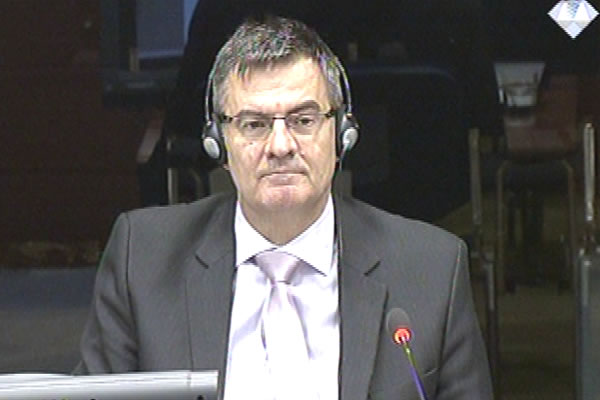Home
NO LINE OF SIGHT FROM SERB POSITIONS TO SNIPER VICTIMS
Mladic’s expert for weapons and military equipment Mile Poparic denies the allegation that the Serb troops were responsible for sniper attacks on Sarajevo civilians. According to Poparic, there was no line of sight from where the victims were to the positions held by the Republika Srpska army
 Mile Poparic, defence witness at Rako Mladic trial
Mile Poparic, defence witness at Rako Mladic trial Ratko Mladic’s defense called Mile Poparic, an expert on firearms and military equipment, in a bid to contest the prosecution’s allegations about the Republika Srpska Army’s responsibility for sniper attacks on Sarajevo civilians. Together with Zorica Subotic, expert on firearms and cold weapons, Poparic has drafted four reports denying the prosecution’s allegations related to the terror campaign against Sarajevo citizens during the 44 months of the siege. During the hearing today the focus was on the report on infantry weapons.
Poparic already testified about his findings at the trial of Radovan Karadzic in 2013. Since then, Poparic explained today, he has amended some of his conclusions relying on the material provided to him by Mladic’s defense. The main problem the witness had to deal with as he prepared his reports was the fact that it was difficult to obtain ‘physical evidence’. In incidents involving infantry weapons, the crime scene changes very quickly and the police either failed to make a record of the physical evidence immediately after the incident or the data were unreliable. According to Poparic, another problem was the lack of forensic medical records to substantiate claims about victims’ ‘injuries’.
In his analysis of the incidents, Poparic relied partly on media reports including the report filed by the Sky News reporter Aernout van Lynden about the Sarajevo firefighters. Van Lynden’s report showed a multi-story building in flames. Based on the footage Poparic concluded that the fire had most occurred after an exchange of fire. Poparic explained that the fire was opened at the Serb positions from that building. When the Serb returned fire, the building went up in flames. Poparic had a back-up theory for the footage: the fire was staged ‘for publicity’. The presence of a team of reporters who recorded the incident led Poparic to that conclusion.
Based on the tracing rounds visible in Van Linden’s footage, Poparic estimated that the fire couldn’t have come from the Republika Srpska Army positions. If a bullet had been fired from Mladic’s positions, the trace would have had to be ‘straight’ and not angled, as it is in the recording. The criteria Poparic used in his analysis apparently failed to impress the judges. Presiding judge Orie thus noted that the images in the video were ‘foreshortened’. Judge Moloto said that only ‘someone hanging from the wall’ could have fired the bullet, because he could plainly see that the trace ended at a wall. The witness claimed that the trace began at a window.
In his analysis of individual incidents listed in the indictment, Poparic concluded that ‘none of the incidents was caused by fire originating from the Metalka building’ in Grbavica. According to the prosecution, Sarajevo trams were shot at from the Metalka building. Poparic also claims that there was no line of sight from the locations where civilians were targeted to the Serb positions. One such example, according to Poparic, is the case of Anisa Pita who was three years old when she was shot. On 13 December 1992, Anisa Pita was shot in the leg on the porch of her family house in Zagric Street. Pita’s parents testified that the bullet had come from the location called Baba Stijena. Poparic claims that the Pita family house is not visible from the Baba Stijena position.
Poparic also analyzed the case of Munira Zametica who was killed on 11 July 1993 as she was fetching water from the Dobrinja river. In that case, Poparic argued, the time of the incident and the location from which the fire was opened remained controversial. Munira Zametica could have been shot from the Orthodox Church located 1,100 meters from the place of the incident but Poparic believed that the bullet had come from somewhere close, or it may have ricocheted off the concrete bottom of the river. The prosecution alleges that the shot was fired by a sniper operating from the Orthodox Church.
Mile Poparic continues his testimony tomorrow.
Linked Reports
- Case : Mladic
- 2015-10-26 FROM VALJEVO VIA JAHORINA TO SREBRENICA
- 2015-10-26 DUSAN DUNJIC DIED OF NATURAL CAUSES
- 2015-10-22 MLADIC’S DEFENSE WITNESS PASSES AWAY
- 2015-10-28 OTHER SIDE RESPONSIBLE FOR SNIPER VICTIMS
- 2015-10-29 PROSECUTION CONTESTS MLADIC’S EXPERT METHODOLOGY
- 2015-11-02 ERRONEOUS PREMISES RESULT IN WRONG CONCLUSIONS
